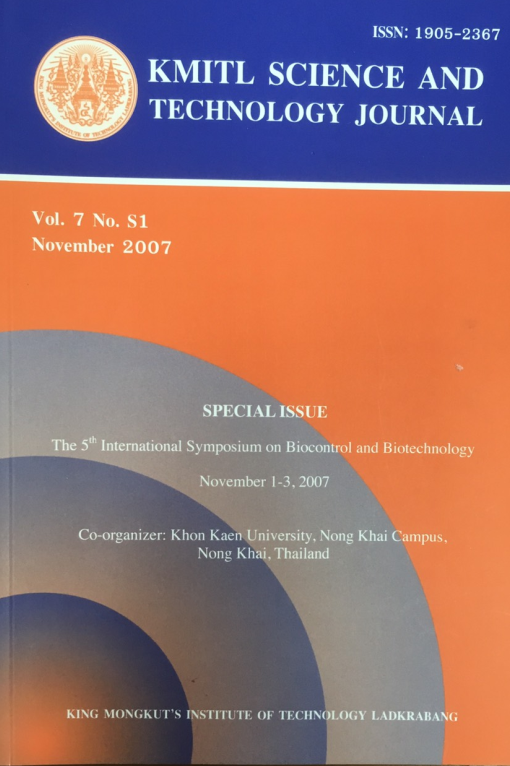SCREENING OF Bacillus spp. SUPPRESING THE INFECTION OF Trichoderma sp. IN MUSHROOM CULTIVATION
Main Article Content
Abstract
The aim of this study is to search for potential Bacillus spp. that can suppress the infection of Trichoderma sp. in Shiitaki mushroom (Lentinus edodes) and oyster mushroom (Pleurotus sajor-caju). Preliminary screening of 30 isolates of Bacillus spp. was performed against the green mold, Trichoderma sp., one of the pathogens of several mushroom cultivation. All bacilli except the commercial product, Plaikaow TM (B. subtilis PKTM) were isolated from infected and non infected mushrooms with Trichoderma sp. Antifungal efficiency was examined by agar diffusion and dual culture assay. Microscopic study revealed that the bacilli caused abnormalities in mycelium, such as cytolysis, vacuole formation, cell-shrink and cell-size reduction. API 50 CHB was used to identify the species of 5 isolates and 4 isolates were found to be B. subtilis (designated as Bs 02-SU2, Bs 05-SU3, Bs 07-SU4 and Bs 09-SU5) while another species was B. licheniformis (Bl 01-SU1). For in vivo test in mushroom house, bacterial cell suspensions from 24 hr. incubation time, pH 7 at 37 0C, containing 106 cell/ml of the 5 selected isolates were injected into the spawn cultivated mushrooms and followed by 106 spore/ml of Trichoderma sp. 2 days later. Trichoderma sp. infected-mushrooms were counted twice a week, for a period of 6 weeks. It was found that the percentage of green mold infection by Bl 01-SU1 on L. edodes and P.sajor- caju was 58.23 and 80, respectively. Its efficacy was equivalent to Bs PKTM (P > 0.05) but was significantly different (P<0.05) from the rest of other bacterial isolates. In addition, all tested bacteria exhibited significantly higher suppression for Trichoderma sp. infected P. sajor-caju than those infected L. edodes.
Keywords: microbial control, microbial antagonism, Bacillus, green mold, Trichoderma, mushroom, Lentinus edodes, Pleurotus sajor-caju
Corresponding author: E-mail: titiya@su.ac.th
Article Details
Copyright Transfer Statement
The copyright of this article is transferred to Current Applied Science and Technology journal with effect if and when the article is accepted for publication. The copyright transfer covers the exclusive right to reproduce and distribute the article, including reprints, translations, photographic reproductions, electronic form (offline, online) or any other reproductions of similar nature.
The author warrants that this contribution is original and that he/she has full power to make this grant. The author signs for and accepts responsibility for releasing this material on behalf of any and all co-authors.
Here is the link for download: Copyright transfer form.pdf
References
[2] Jamsawang, J. 2004 Capable of Trichoderma spp. To Induce Plant Development of Resistance to Plant Diseases, Journal of Fruit Town, 4(4), 83-84.
[3] Powell, K.A. and Justum, A.R. 1993 Technical and Commercial Spects of Biological Control Products, Pesticide Science, 37(2), 315-321.
[4] Emmert, E.A.B. and Handelsman, J. 1999 Biologcal Control of Plant Disease: A Gram Positive Prospective, FEMS Microbial Letter, 171(2), 1-9.
[5] Stanek, M. 1974 Bacteria Associated with Mushroom Mycelium Agricus bisporus in Hyposphere, Mushroom Science, 8(1), 197-207.
[6] Wilson, M. and Lindow, S.E. 1994 Coexisting among Epiphytic Bacteria Populations Mediated Through Multiple Resources Partitioning, Applied and Environmental Microbiology, 60(12), 4468-4477.
[7] Shoda, M. 2000 Bacteria of Plant Diseases, Journal of Bioscience and Bioengineer, 89(2), 515-521.
[8] www.http://www.thaiagro.com/effect of the use of Bacillus subtilis in mushroom cultivation.
[9] Montesions, E., Bonatera, A., Badosa, E., Frances, J., Alemany. J., Llorente, I. and Moragrega, C. 2002 Plant- Microbe Interactions and New Biotechnological Methods of Plant Disease Control, International Microbiology, 5(1), 169-175.
[10] Nawa, L.S. 2007, Pathological and Rhizospherical Studies on Root-Rot Disease of Squash in Saudi Arabia and Its Control, African Journal of Biotechnology, 6(3), 219-226.
[11] Liu, Y., Chen, Z., Ng, T.B., Zhang, J., Zhou, M., Song, F., Lu, F. and Liu, Y. 2007 Basizubin, an Antifungal Protein with Ribonuclease and Hemagglutinating Activities from Bacillus subtilis Strains B-916, Peptides, 28(3), 553-559.
[12] Tsimilli-Michael, M., Eggenberg, P., Biro, B., Koves-Pechy, K., Voros, I. and Strasser, R.J. 2000 Synergistic and Antagonistic Effects of Arbuscular Mycorrhizal Fungi and Azospirillum and Rhizobium Nitrogen – Fixers on the Photosynthetic Activity of Alfalfa, Probed by the Fluorescin Screening, Applied Soil Ecology, 15(2), 169-182.
[13] Wang, H. and Ng, T.B. 2004 Eryngin, a Novel Antifungal Peptide from Fruiting Bodies of the Edible Mushroom Pleurotus eryngii, Peptides, 25(1), 1-5.
[14] Chu, K.T., Xia, L. and Ng, T.B. 2005 Pleurostrin, An Antifungal Peptide from the Oyster Mushroom, Peptides, 26(11), 2096-2103.
[15] Hatvani, N. 2001 Antibacterial Effect of the Culture Fluid of Lentinus edodes Mycelium Grown in Submerged Liquid Culture, International Journal of Antimicrobial Agents, 17(1), 71-74.
[16] Hatvani, N., Kredies, L., Antal, Z. and Mecs, I. 2002 Change in Activity of Extracellular Enzynes in Dual Culture of Lentinula edodes and Mycoparasitic Trichoderma Strains, Applied and Environmental Microbiology, 92(3), 415-423.


